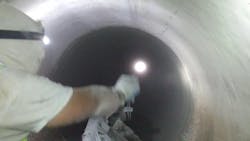Orlando International Airport Taxiway Gets Structural Underground Rehab
Orlando International Airport (MCO) is one of the world’s busiest airports and, by area, the third largest in the U.S. Interestingly, the airport also is used as a space shuttle emergency landing site.
But in the mid-2000s, overall passenger numbers were down at MCO, and the airport embarked on a massive capital improvements plan from 2009 to 2014 to reclaim its place among the world’s great airports. Much of the work had to do with terminal improvements, but runways and taxiways were also inspected and rehabilitated as needed—and there were improvements below the airfield as well. In 2014, video inspection of two 42-in. storm sewers running parallel underneath the taxiway serving MCO’s 18R/36L runway—a giant concrete strip that is 12,004 ft long—showed a reinforced concrete pipe that was failing badly; joints were delaminating, fairly long cracks had emerged, and some leaks and failures had appeared. “There weren’t any surface issues yet, but it was obvious that something had to be done,” said Anita Clyne, president of Utility Asset Management.
But deciding just what to do was a challenge. Trench and replace was out of the question, as airfield infrastructure is highly engineered and difficult and expensive to replace. Cured in place pipe (CIPP) was not considered a good option because it is expensive to use in large diameter pipe, and sometimes fails during installation, which could add weeks or months to taxiway closure. And both sliplining and CIPP would reduce the sewer’s hydraulic capacity. General contractor Middlesex Corp. eventually worked with trenchless technology developer AP/M Permaform to evaluate and engineer a centrifugally cast concrete pipe (CCCP) solution based on their CentriPipe technology. They hired Anita Clyne’s company, UAM, to do the actual CentriPipe installation.
Working with Escorts
CentriPipe is a CCCP solution based primarily on two innovations, a concrete spincaster and a line of fine aggregate composite concretes (FACC), both developed by AP/M Permaform. The CentriPipe spincaster is inserted into sewer lines and withdrawn on a sled while spraying thin, smooth layers of FACC, which is mixed on site.
The FACC products used with the CentriPipe process incorporate precisely graded quartz sands, non-metallic fibers, and other complex admixtures to achieve a unique blend of strength and other properties that make them choices for horizontal pipe and sewer rehabilitation. Thixotropy (a measure of viscosity) is engineered to produce a concrete mix that can be pumped long distances, adheres tightly to most substrates (including plastics and corrugated metal pipe), and cures quickly. PL-8000, the FACC used for the MCO sewer rehabilitation, also has very low permeability for better freeze/thaw performance, and extremely high thin shell toughness.
The end result of the process is a thin-walled concrete pipe—just one-in. thick on this project—cast inside the original storm pipe without hand troweling. The new pipe is structurally sound even when the original pipe is failing, and reduction of the sewer’s hydraulic capacity is negligible.
Aside from the setting—a busy, highly regulated, international airport—the work at MCO was straightforward. A total of 600 ft of sewer line ran beneath the taxiway, and dewatering was accomplished fairly easily by bypass pumping into one or the other of the two parallel lines. Entry access was available from both sides of the taxiway, so CentriPipe passes never exceeded 150 ft. UAM began work with high-pressure cleaning of the RCP structure and some minor patching and chemical grout sealing of failing joints.
Then, working alternately from side to side and end to end, two CentriPipe passes were completed in each section of 42-in. sewer for a total new pipe thickness of one inch. Quality control was achieved by the use of depth gauges, visual inspection, and by monitoring the bags of PL-8000 used and calculating the total volume of material applied.
But working on an active airfield does present difficulties, even though the taxiway was closed to all but cross traffic during the project. “Following all the security and safety procedures and dealing with the mandatory escorts was tough at times,” Clyne admitted. “Even bathroom breaks were something of a chore—if one crew member had to use the restroom, we all had to go, so the escort could keep an eye on all of us.”
But even with all the extra regulation, UAM was on the site for less than three weeks, which means that MCO’s vital taxiway was back in service far sooner than initially expected. The successful use of CCCP in this highly visible, highly regulated project is a testament to the CentriPipe process’ cost-effectiveness, structural strength, efficiency and speed of installation.

